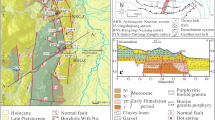Abstract
Two Holocene sediment cores were retrieved respectively from the enclosed Lake Daihai in the monsoon/arid transition zone of North China and the Taihu Lake coast in the monsoonal area of the Yangtze delta, Eastern China. Distribution of major geochemical elements and their ratios were employed to reveal the characteristics of Holocene climate and associated environmental implications in the two regions. It is suggested that the temporal distribution of major elements serve as a useful indicator to denote the variations of monsoon effective precipitation for the enclosed lake area. High values of resistant elements such as Al2O3, SiO2, TiO2, (FeO + Fe2O3), MnO in the lake sediments correspond to the depressed chemical weathering and weakened mon-soon effective precipitation, while the highs of mobile and easy soluble elements such as MgO, CaO, Na2O reflect the enhanced chemical weathering and increased monsoon effective precipitation in the lake basin. In comparison, the behaviors of the major elements in sediments of the Taihu Lake coast were largely controlled by the changes both in sea transgression in the different Holocene time periods and the monsoon precipitation. The relatively highs of Al2O3, TiO2, (FeO + Fe2O3), in marine-influenced sediments suggest relatively strong coastal hydrodynamics and chemical weathering, and vice versa. Meanwhile, the lows of SiO2, Na2O and CaO in the non-marine-influenced sediments also denote relatively strong hydrodynamics and chemical weathering due to enhanced monsoon precipitation, and vice versa. Sedimentary environment should be taken into account when achieving a full understanding of their climate implications.
Similar content being viewed by others
References
Aldahan A, Possnert G, Scherer R, Shi N, Backman J, Bostrom K (2000). Trace-element and Major-element stratigraphy in Quaternary sediments from the Arctic Ocean and implications for glacial termination. Journal of Sedimentary Research, 70: 1095–1106
Blands W, Rolls D (1998). Weathering, An Introduction to the Scientific Principles. London: Arnold, 271
Brown E T, Callonnec L L, German C R (2000). Geochemical cycling of redox-sensitive metals in sediments from Lake Malawi: A diagnostic paleotracer for episodic changes in mixing depth. Geochimica et Cosmochimica Acta, 64: 3515–3523
Chen Z Y, Wang Z H, Schneiderman J, Tao J, Cai Y L (2005). Holocene climate fluctuations in the Yangtze delta of eastern China: the Neolithic response. The Holocene, 15: 917–926
Chinese Academy of Sciences (Compilatory Commission of Physical Geography of China) (1984). Physical Geography of China: Climate. Beijing: Science Press, 1–30 (in Chinese)
Compilatory Commission of Annals of Liangcheng County (1993). Annals of Liangcheng County. Hohhot: People’s Press of Inner Mongolia, 85–102 (in Chinese)
Gao Y X (1962). On some problems of Asian monsoon. In: Gao Y X, ed. Some Questions about the East Asian Monsoon. Beijing: Science Press, 1–49 (in Chinese)
Koinig K A, Shotyk W, Lotter A F, Ohlendorf C, Sturm M (2003). 9000 years of geochemical evolution of lithogenic major and trace elements in the sediment of an alpine lake-the role of climate, vegetation, and land-use history. Journal of Paleolimnology, 30: 307–320
Lasaga A C, Soler J M, Ganor J, Burch T E (1994). Chemical weathering rate laws and global geochemical cycles. Geochimica et Cosmochim Acta, 58: 2361–2386
McLennan S M, Hemming S, McDaniel D K, Hanson G N (1993). Geochemical approaches to sedimentation, provenance and tectonics. In: Johnson MJ, Basu A, eds. Processes Controlling the Composition of Clastic Sediments. GSA Special Paper, 284: 21–39
Nesbitt H W, Young G M (1982). Early Proterozoic climate and plate motions inferred from major element chemistry of lutites. Nature, 299: 715–717
Tao J, Chen M T, Xu S Y (2006). A Holocene environmental record from the southern Yangtze River delta, eastern China. Palaeogeo-graphy, Palaeoclimatology, Palaeoecology, 230: 204–229
Wang S M, Yu Y S, Wu R J, Feng M (1990). The Daihai Lake: Environment Evolution and Climate Change. Hefei: University of Science and Technology of China Press, 1–191 (in Chinese)
Weinert H H (1965). Climatic factors affecting the weathering of igneous rocks. Agricultural Meteorology, 2: 27–42
White A F, Blum A E (1995). Effects of climate on chemical weathering in watersheds. Geochimica Cosmochim Acta, 59: 1729–1747
Xiao J L, Xu Q H, Nakamura T, Yang X L, Liang W D, Inouchi Y (2004). Holocene vegetation variation in the Daihai Lake region of north-central China: A direct indication of the Asian monsoon climatic history. Quaternary Science Reviews, 23: 1669–1679
Zhang J C, Lin Z G (1992). Climate of China. New York: Wiley, 376
Author information
Authors and Affiliations
Corresponding author
Rights and permissions
About this article
Cite this article
Sun, Q., Wang, Z., Chen, J. et al. Climate implications of major geochemical elements in the Holocene sediments of the North and East China monsoonal regions. Front. Earth Sci. China 3, 291–296 (2009). https://doi.org/10.1007/s11707-009-0035-3
Received:
Accepted:
Published:
Issue Date:
DOI: https://doi.org/10.1007/s11707-009-0035-3




